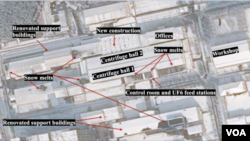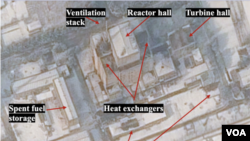North Korea appears to have resumed uranium enrichment plant (UEP) operations at its Yongbyon facility used to make nuclear weapons, according to a former nuclear inspector after analyzing satellite imagery that revealed new activities.
Ollie Heinonen, former deputy director-general for safeguards at the International Atomic Energy Agency (IAEA), told VOA’s Korean Service that satellite images of North Korea’s Yongbyon nuclear facility show that buildings comprising the UEP are in operation.
Heinonen’s assessment comes as North Korea has been reminding the world of its nuclear capability.
In January, Pyongyang tested 11 missiles, including an intermediate-range ballistic missile launched on January 30 capable of reaching the U.S. territory of Guam. A series of satellite images ending on January 16 suggested North Korea has not abandoned its Punggye-ri Nuclear Test Facility, sealed by an explosion witnessed by members of the foreign press in May 2018. Also in January, the regime announced it would consider repealing a self-imposed moratorium, raising a possibility for a nuclear or intercontinental ballistic missile (ICBM) test.
Heinonen said snow melts on the roofs of several buildings making up the UEP indicate heat is being generated because the plant is in operation.
VOA’s Korean Service emailed the North Korean mission at the United Nations for a comment on Heinonen findings but received no response.
“The most important signs are the snow melts in the section which contains the control room and stations for feeding and withdrawing uranium hexafluoride from the enrichment halls,” Heinonen said on Sunday.
“These sections should only be heated when the facility operates,” said Heinonen, who is now a distinguished fellow with the 38 North program at the Stimson Center.
Uranium hexafluoride is a chemical form of uranium used during the process of enriching uranium, a key ingredient for making nuclear weapons.
Nuclear weapons can be made either at a uranium enrichment plant or a facility that produces highly enriched uranium.
Heinonen said snow melts on the plutonium plant also indicate North Korea is continuing its operation there.
“In wintertime, melting of snow first on the roofs of certain sections of the reactor generating heat are the main indicators,” of a plutonium plant in operation, Heinonen said.
Renewed activity
According to the latest IAEA report released in August 2021, North Korea has not started its UEP although its 5-megawatt plutonium producing reactor was in operation.
“Since early July 2021, there have been indications consistent with the operation of the 5MW(e) reactor,” the report said.
“While regular vehicle movements were observed, there were indications, for a period of time, that the Yongbyon reported centrifuge enrichment facility was not in operation,” the report continued.
The centrifuge enrichment facility is a part of UEP plant where rotating cylinders called centrifuges are located and used to enrich uranium.
Miniaturized warhead
David Albright, a former United Nations nuclear inspector and current president of the Institute of Science and International Security (ISIS), said, “If the [uranium] plant was going to be operational, [the North Koreans] have to keep the temperature of a centrifuge plant at about 70 degrees Fahrenheit year-round, so you need heat in the winter, cooling in the summer.”
Albright said, however, it is uncertain whether North Korea is working to produce highly enriched uranium.
Instead, he said, North Korea could have begun the operation of the UEP to produce low enriched uranium that can be used in the light water reactor at Yongbyon capable of producing plutonium. Albright said the construction of the light water reactor at Yongbyon appears largely finished but not yet in operation.
“North Korea has a lot of highly enriched uranium for weapons, and does it actually need any more?” Albright said.
He suggested North Korea could be focusing on producing plutonium that could be used to make miniaturized nuclear weapons.
“Plutonium is easier to compress than weapons-grade uranium,” Albright said. “So plutonium is preferred [over uranium] to miniaturize as weapons.”
In response to Heinonen’s findings of the uranium and plutonium plants operating at North Korea’s Yongbyon nuclear complex, the South Korean Unification Ministry said on Monday the government is monitoring activities at Yongbyon closely.
Unification Ministry spokesperson Lee Jong-joo said, “With regard to North Korea’s nuclear and missile activities, including Yongbyon, [we] have been closely tracking and monitoring [them] on the basis of close South Korea-U.S. coordination.”
A U.S. State Department spokesperson responded to Heinonen’s findings by stating on Monday that “the DPRK constitutes a threat to international peace and security and the global nonproliferation regime.” The DPRK stands for North Korea’s official name, the Democratic People’s Republic of Korea.
The spokesperson continued, “The United States has a vital interest in deterring the DPRK, defending against its provocations or uses of force, limiting the reach of its most dangerous weapons programs, and above all keeping the American people, our deployed forces, and our allies safe.”
Journalist Jiha Ham contributed to this report, which first appeared on VOA’s Korean Service.





